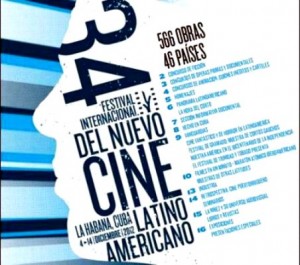 Every December, like a returning friend, the Havana International Festival of New Latin America Cinema returns. A film event that this year will bring more than 500 movies from 46 countries. A true delight for our senses, the Festival includes a visit to the country of actors and directors from all latitudes, thematic film showings, and even concerts. From Fito Paez’s massively-attended presentation, through the American actress Annette Bening, to the filmmaker Eliseo Subiela.
Every December, like a returning friend, the Havana International Festival of New Latin America Cinema returns. A film event that this year will bring more than 500 movies from 46 countries. A true delight for our senses, the Festival includes a visit to the country of actors and directors from all latitudes, thematic film showings, and even concerts. From Fito Paez’s massively-attended presentation, through the American actress Annette Bening, to the filmmaker Eliseo Subiela.
Tributes to the leading figures of celluloid are also part of the offerings of the two weeks that the greater part of the activities last. This time the honorees are French filmmaker Chris Marker (1921-2012), the Italian Michel Angelo Antonioni (1912-2007) and the Czech master of animation Jan Svankmajer (1934).
This year 21 feature-length films, as well in the other categories of documentaries, shorts, animation, scripts, posters and debut films. There will be a retrospective for the centennial year of film production in Puerto Rico, with more than 20 titles and the usual showings dedicated to Spain, Italy, Canada and Poland.
Among the big surprises on this occasion is a series of films grouped under the title “From Hollywood to Havana,” which will be presented by the president of the US Academy of Motion Picture Arts and Sciences himself, Hawk Koch.
However, beyond the high quality of the films and collateral programs, the Festival is surrounded by a magical aura. It is something that can’t be described, neither with the number of titles in the catalog, nor with the significance of the international stars who are coming. It’s something deeper in our skin, closer to the personal biographies of those of us who have come of age looking forward to every December.
For example, my adolescence is inextricably linked the very long lines to see an Argentine or Mexican film. Still vivid is the sense of wonder when one night the glass in the doors of the Acapulco cinema where shattered before my eyes by the push of people eager to enter. The furtive kiss in the darkness of the room, while the a brilliant tropical rainforest shimmered on the screen and a horse whinnied from the speakers. Days also that I sat in the seats through so many films I’d seen in a few hours. We were so young and at that time the film festival was as well.
After 34 years of the inauguration of the Havana Latin American Film Festival, the social reality in which is operates has changed dramatically. I could list endless transformations that happened in Latin American film, but I prefer to concentrate on the changes within us, on this side of the screen. Among the major differences that I perceive relative to the Film Festivals of the ‘70s, notable are the new forms of access to popular films. Before, we were totally dependent on the schedules in the State-owned projection rooms. So if a particular movie was not programmed for these public spaces, there was no chance that we would see it.
This happened very often, either because of censorship, disinterest, or the lack of rights to show a film on the national circuit. Very timidly, in the mid-eighties, the first VCR players appeared in homes. And this began to totally change our relationship to the audio-visual world.
Now, proliferating all over the city are video rooms operated by the self-employed, and many families have at least one DVD-player to watch documentaries, movies and television shows that never become part of the official programs. A wave of commercial films, but also documentaries censored for their ideology, have made their way to us thanks to modern technology.
And that is now the great challenge and main competition for the International Festival of New Latin American Cinema. Getting people to leave their home screens and return to the projection rooms, to motivate them with an event that up until a few years ago was the only window we had to get a peek at a fresh and different cinema.
5 December 2012
